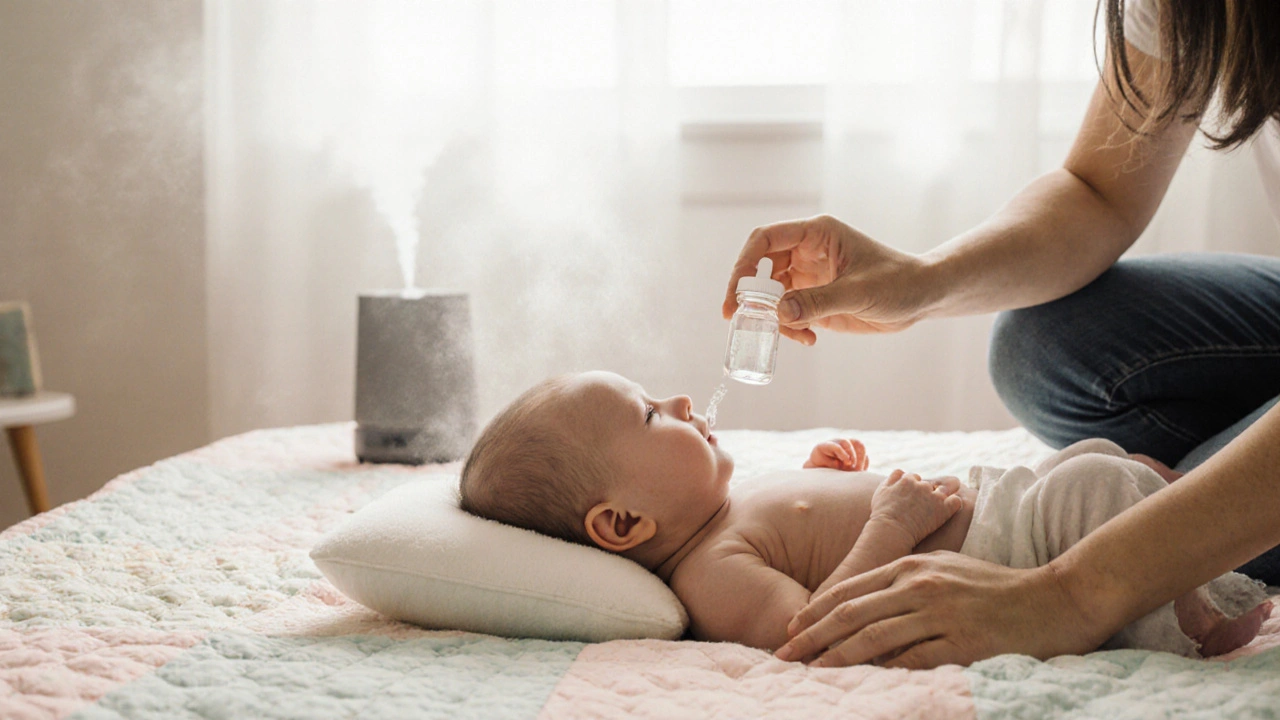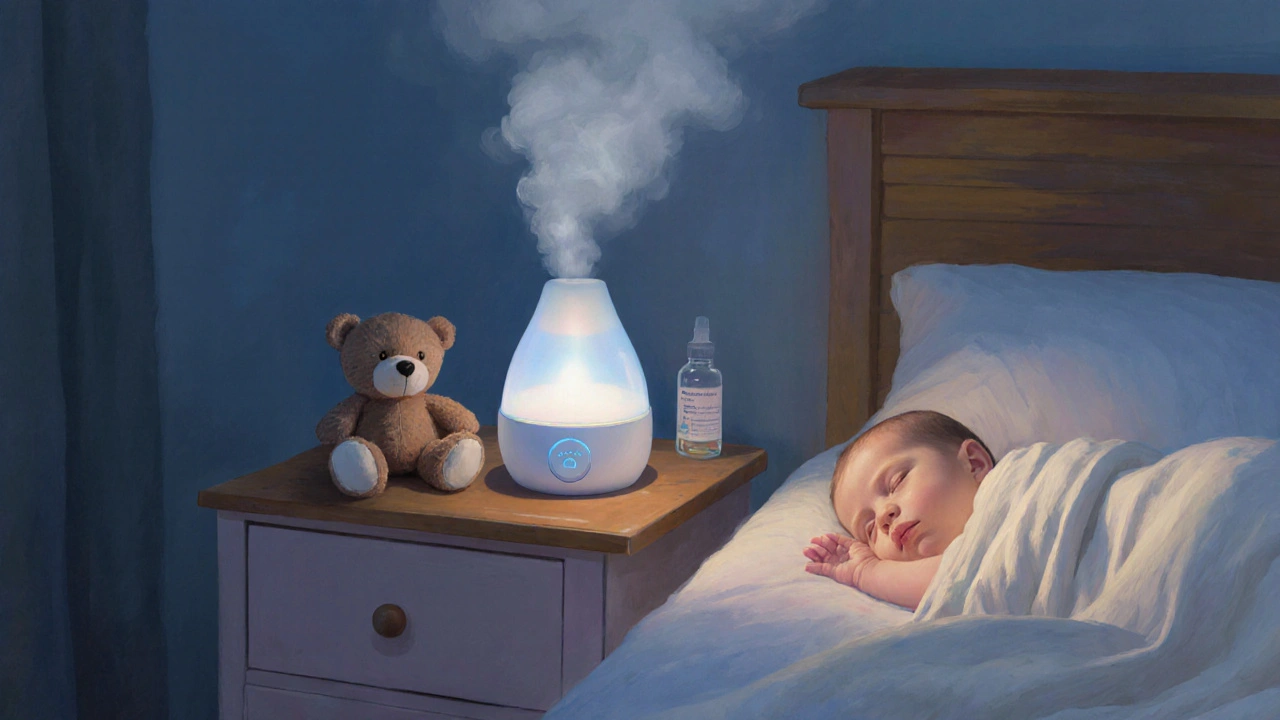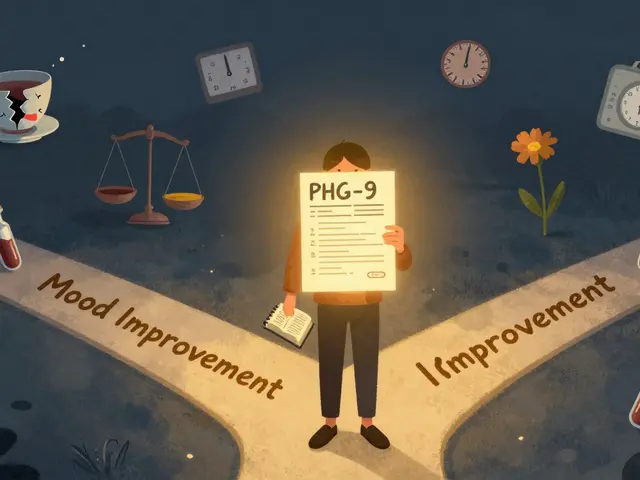
Baby Runny Nose Checker
This tool helps parents decide whether to contact a pediatrician based on symptom severity and duration.
runny nose in babies is one of the first signs parents notice when their little one catches a cold, but not every sniffle needs a medicine cabinet. Below you’ll find a practical roadmap that lets you soothe the drip without risking side‑effects.
Quick Takeaways
- Use saline drops and a gentle nasal aspirator for immediate relief.
- Keep the air moist with a cool‑mist humidifier; avoid hot steam.
- Offer extra fluids - breast‑milk, formula, or water (after 6 months).
- Skip over‑the‑counter cough‑colds for under‑2‑year‑olds; they’re not safe.
- Call a pediatrician if the runny nose lasts more than 10 days, comes with fever, or the child can’t feed.
What’s Actually Behind That Drip?
Most of the time a runny nose in infants and toddlers is caused by a viral upper respiratory infection, commonly called the "cold". The virus inflames the nasal lining, prompting excess mucus to protect the delicate tissue.
Allergies can mimic the same symptoms, especially when pollen or pet dander stirs up in spring. Less often, a bacterial infection or a structural issue (like enlarged adenoids) may be at play, but those scenarios usually bring additional red flags such as persistent fever or breathing trouble.
When a Drip Becomes a Panic Button
Parents naturally wonder if a simple sniffle could hide something serious. Here are the tell‑tale signs that warrant a call to your pediatrician the child's primary medical professional, trained to assess infant health concerns:
- Fever over 38.5°C (101.5°F) that lasts more than 24hours.
- Persistent coughing that interferes with feeding or sleep.
- Blue‑tinged lips or difficulty breathing.
- Runny nose that turns thick, green, or lasts beyond two weeks.
- Unexplained lethargy or irritability.
If any of these pop up, seek professional advice promptly - early intervention can prevent complications.
Safe Home Remedies: What Works and Why
Below are the evidence‑backed tactics you can start right now.
1. Saline Nasal Drops
Saline is simply sterile salt water. When you place a few drops in each nostril, the solution thins the mucus, making it easier to clear.
For infants, use a saline nasal drops pre‑measured, sterile drops designed for baby nasal passages that come in a squeezable bottle. Follow these steps:
- Lay the baby on their back with their head slightly tilted back.
- Gently squeeze 2-3 drops into each nostril.
- Wait 30seconds, then use a soft nasal aspirator (see below).
Do this 2-3 times a day while symptoms last.
2. Gentle Nasal Aspirator
Aspirators remove the loosened mucus without forcing air into the nose. The classic “bulb” style works fine, but a newer “suction tube” with a filter offers better hygiene.
To use:
- Before each use, sterilize the tip by boiling it for 5minutes.
- Squeeze the bulb, gently insert the tip into one nostril (not deeper than the first bend), and release.
- Repeat on the other side, then clean the device.
Never insert the tip too far - the aim is to pull mucus out, not to cause irritation.
3. Cool‑Mist Humidifier
Dry indoor air can thicken secretions, making the baby's nose feel clogged. A humidifier a device that adds moisture to indoor air, preferably a cool‑mist model for safety set to a low setting in the nursery helps keep the mucus thin.
Keep the water reservoir clean - change water daily and wipe the base weekly to prevent mold.
4. Keep Fluids Flowing
Hydration is key. For babies under 6 months, breast‑milk or formula provides adequate fluid. Once the child turns six months, you can introduce small sips of water in a cup.
Warm liquids (like diluted, unsweetened apple juice) can also soothe the throat and stimulate nasal drainage.
5. Gentle Steam (Not Hot)
Steamy bathrooms can help, but never place a child directly in hot steam. Run a warm shower, close the door, and sit with your baby in the bathroom for 5-10minutes. The moist air can ease breathing without the burn risk of a kettle.
6. Breast‑Milk Nasal Drops (for Breast‑Feeding Moms)
Some parents swear by a few drops of their own breast‑milk in each nostril. The antibodies may offer a mild anti‑inflammatory boost, though scientific data is limited. If you try it, ensure the milk is fresh and the droplet is tiny to avoid choking.

What to Avoid: Common Pitfalls
Even well‑meaning parents can slip into unsafe habits. Here’s a quick checklist.
- Over‑the‑counter cold medicines: The FDA warns against cough‑colds for children under 2years. They can cause rapid heart rate, seizures, or worse.
- Honey: Safe after 12months, but can trigger infant botulism in younger babies.
- Vaping or scented candles near the child: Irritants worsen nasal inflammation.
- Rubbing the nose too hard: The delicate skin inside a baby's nostril can bleed or become inflamed.
Home Remedy vs OTC: Quick Comparison
| Aspect | Home Remedy | OTC Option |
|---|---|---|
| Safety (0‑24months) | Generally safe when used as directed | Not recommended; risk of serious side‑effects |
| Effectiveness | Helps thin mucus, relieves congestion | May reduce symptoms but often masks underlying cause |
| Cost | Low (saline packets, clean water) | Higher (medication bottles) |
| Ease of Use | Requires gentle technique (aspirator, drops) | Simple - just give the dose |
| Doctor Recommendation | First‑line treatment | Second‑line only after pediatrician advice |
When to Call the Pediatrician
Even with the best home care, some scenarios demand professional input.
- Fever persists beyond 48hours.
- Runny nose is accompanied by ear pulling, suggesting an ear infection.
- Child refuses to drink, leading to signs of dehydration (dry mouth, fewer wet diapers).
- Repeated episodes of runny nose that seem seasonal - could be allergic rhinitis.
Having a prepared list of symptoms, the child’s temperature log, and recent exposure history (day‑care, sick relatives) will make the tele‑health or office visit smoother.
Putting It All Together: A Day‑by‑Day Plan
Here’s a simple schedule you can follow for the first 3-5days of a cold.
- Morning: Use saline drops, then aspirate. Offer a bottle or breast‑milk.
- Mid‑day: Run the humidifier on low. Keep the room at a comfortable temperature (68-72°F).
- Afternoon: Repeat the saline‑aspirator routine if the nose is still congested. Take your child for a short walk outside for fresh air (avoid pollen spikes).
- Evening: Warm bath, then a 5‑minute steam session in the bathroom. Finish with another drop‑and‑aspirate cycle.
- Night: Keep the humidifier on, change diaper frequently, and monitor temperature.
Adjust frequency based on how the child feels - the goal is relief, not irritation.
Frequently Asked Questions
Can I give my toddler over‑the‑counter cold medicine?
No. The FDA advises against any cough or cold medication for children under 2years because of serious risks like rapid heart rate, seizures, and even death. Always consult a pediatrician before giving any medication.
How often can I use saline drops?
Two to three times per day is safe. If the mucus is very thick, you can add a fourth session, but avoid over‑doing it as it may dry out the nasal lining.
Is steam therapy safe for a baby?
Yes, as long as you keep the water temperature warm (not boiling) and stay in the bathroom with the child. Never place a baby in a steamy enclosure or hold them over hot water.
When should I suspect an allergy instead of a cold?
If the runny nose is clear, watery, and lasts for weeks, especially during specific seasons or after exposure to pets, it’s likely allergic rhinitis. A pediatrician can recommend a mild antihistamine safe for toddlers.
Can I use a cotton swab to clean my baby's nose?
Avoid cotton swabs inside the nostril. They can push mucus deeper and cause tiny injuries. Stick to saline drops and a soft aspirator.






16 Comments
If you're still considering over‑the‑counter cold medicines for a toddler, you clearly haven't read the FDA warning that these products can cause rapid heart rate, seizures, or even death. Everyone who cares about child safety should know that the only safe route is to stick with saline drops and a gentle aspirator. The article's advice on keeping humidifiers clean is spot on, but it's disappointing how many parents ignore the mold risk. Also, the suggestion to avoid honey before a year old is not optional – it's a serious botulism danger. Seriously, if you can't follow these basic guidelines, maybe you should hand over care to someone more responsible.
/p>Honestly, all this hype about saline drops feels overblown. I mean, kids have survived colds for centuries without a bottle of sterile salt water. If the baby can still breathe and eat, why waste money on a fancy aspirator? The article makes it sound like a high‑tech solution, but a simple tissue will do the job just fine. Maybe we’re just over‑complicating something that’s naturally self‑limiting.
/p>Wow, this guide is a lifesaver! 🌟 I love how you break everything down into easy steps – even a sleep‑deprived parent can follow along. The emoji‑friendly tone makes it feel less clinical and more like a friendly chat. Saline drops and a humidifier are definitely my go‑to tools now. Thanks for the thoroughness and the gentle reminder to avoid OTC meds – that’s crucial! 🙏
/p>The article mentions using a cool‑mist humidifier, but I’m curious about the ideal humidity range. Is 40‑50% really enough to keep the mucus thin without encouraging mold? Also, how long should parents keep the humidifier on at night? A quick clarification would help help those of us trying to fine‑tune the environment.
/p>Those are great questions! In my experience, keeping humidity around 45% works well – it’s moist enough to thin mucus but not so wet that it fosters mold. Running it for the whole night is fine as long as you clean the unit daily.
/p>I really appreciate the depth of this post. It’s clear you put a lot of effort into covering both the “what” and the “why.” The step‑by‑step schedule feels realistic for busy parents. Thanks for making the info accessible without being condescending.
/p>Whoa, another deep dive into saline drops? How original. 🙄 I guess next we’ll get a thrilling exposé on the revolutionary art of wiping noses with a paper towel. Seriously, the medical community has been doing this forever – no need to reinvent the wheel.
/p>Saline drops are cheap and effective.
/p>First of all, congratulations on taking the time to research something as universal as a runny nose in little kids.
/p>Your step‑by‑step plan reads like a checklist that any new parent could hang on the fridge.
I especially love the way you break down the saline‑drop routine into bite‑size actions.
The tip about sterilizing the aspirator tip by boiling for five minutes is a safety gem that many overlook.
Keeping the humidifier clean and changing the water daily is another detail that can prevent mold, which could otherwise irritate a baby's delicate airways.
You also wisely warn against over‑the‑counter cold medications, echoing the FDA's stark warning about potential heart issues and seizures.
Your inclusion of when to consider allergies versus a viral infection helps readers differentiate two often confused conditions.
I appreciate the clear visual cues-clear versus yellow or green mucus-and how they tie into the duration thresholds.
The day‑by‑day schedule you propose is realistic, giving parents a manageable routine without overwhelming them.
Your suggestion to monitor the room temperature between 68‑72°F adds a layer of comfort that many forget.
I also like the reminder to watch for dehydration signs like fewer wet diapers, which can be a silent alarm.
The FAQ section wraps up the article neatly, addressing common myths such as the safety of honey before one year.
Overall, the article strikes a fine balance between medical rigor and parent‑friendly language.
One small improvement could be a quick reference chart at the top for busy parents who skim.
Nonetheless, you’ve packed a wealth of evidence‑based advice into a single, digestible post.
Keep up the fantastic work, and thank you for making pediatric care a little less intimidating for us all.
While the article is comprehensive, I find the prose a bit bloated. A more succinct version would serve the hurried reader better. Nevertheless, the core recommendations are sound.
/p>I’m impressed by the thoroughness, especially the sections on when to seek professional help. The tone feels respectful and considerate of parental anxiety.
/p>Look, the science is crystal clear: saline drops, humidifier, no OTC meds. 🙂 If you’re still not convinced, maybe you need to revisit basic pediatric guidelines. Trust the data.
/p>Yo, this post is legit. Gotta say the step‑by‑step vibe is super helpful. I’m gonna start using the salin drops 2x a day, no prob. Keep it up!
/p>Great job! 🎉 The guide feels friendly and colorful, and the emojis make it fun to read. Keep spreading the good info! 😊
/p>This is an excellent, well‑structured guide. The precise language and actionable steps empower parents to handle a runny nose confidently. Well done.
/p>Love how you kept it real and informal – makes the info easy to digest. 👍 Let’s keep the conversation going, fam! 🌟
/p>